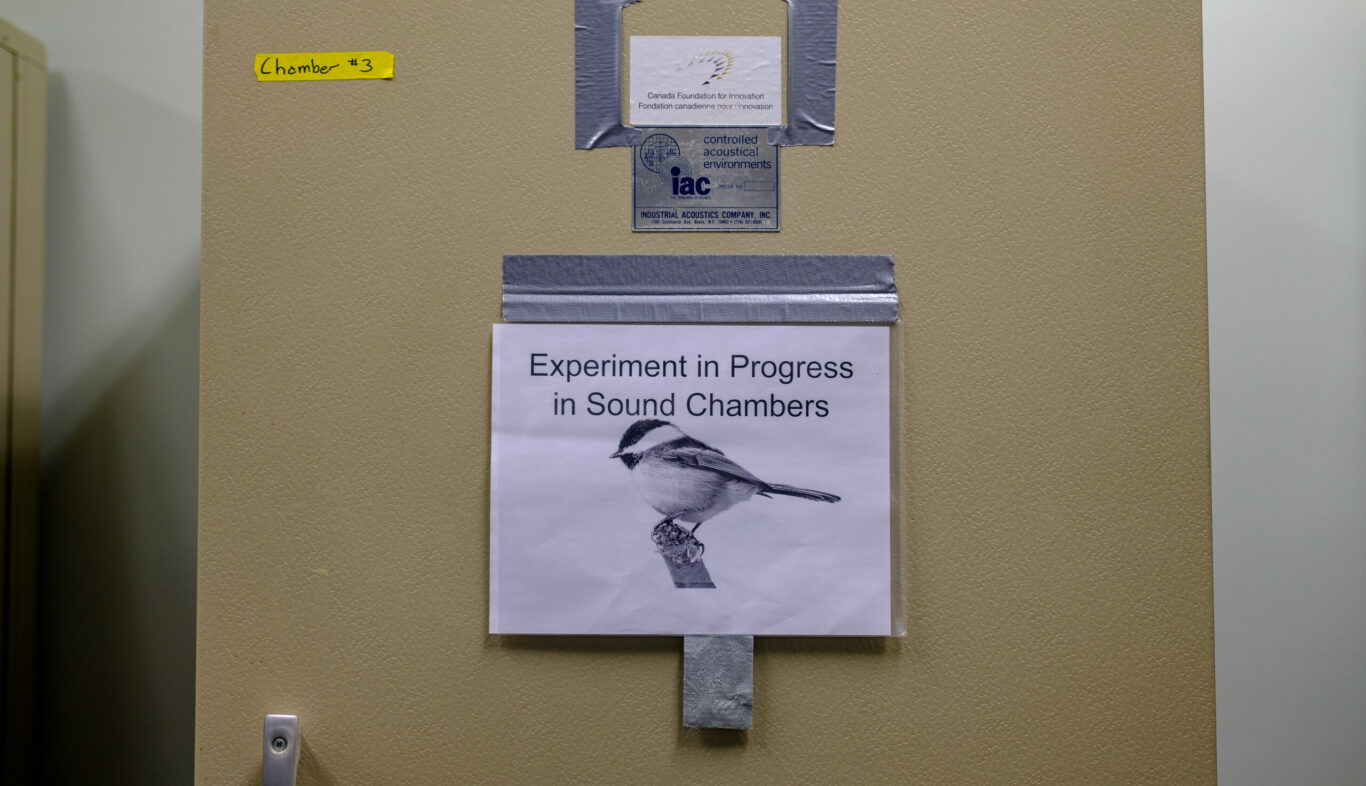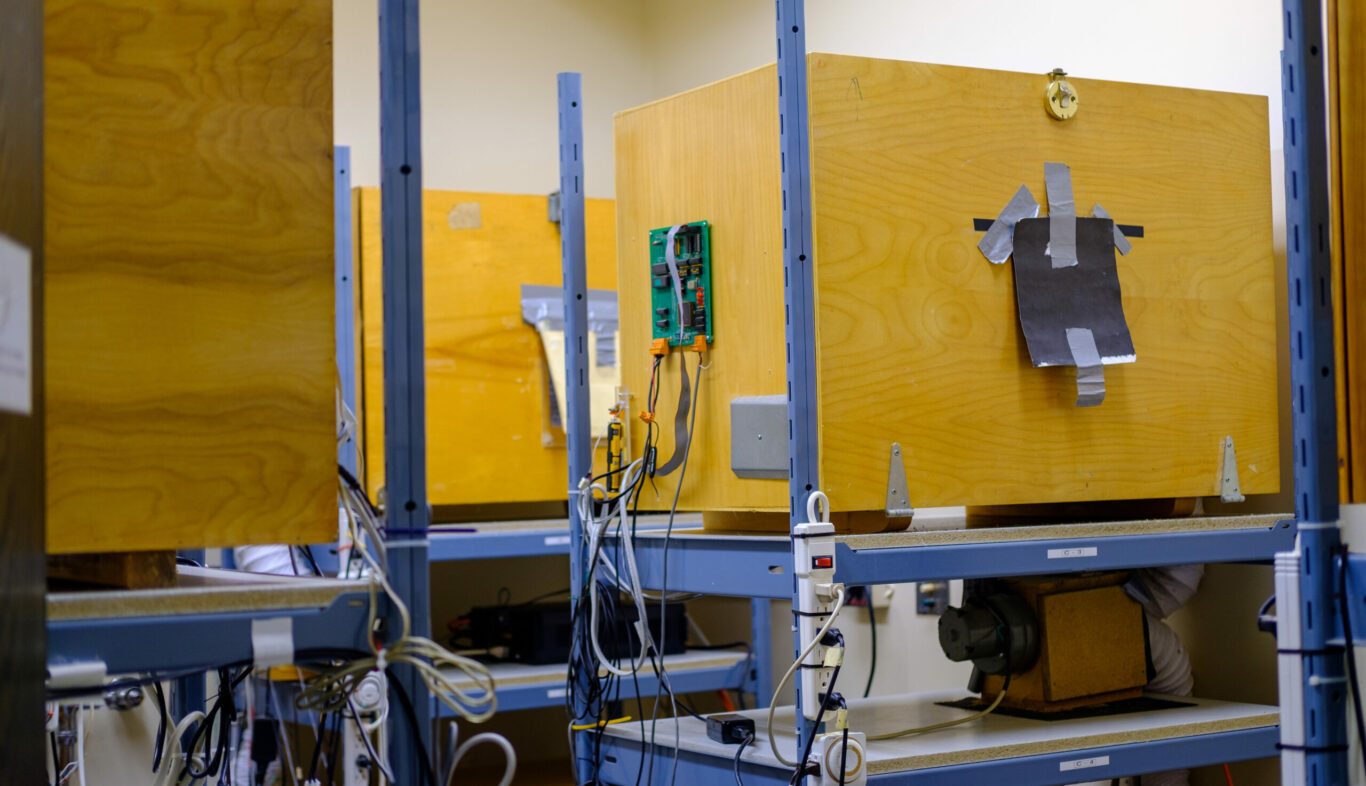Research in the SNL seeks to develop as comprehensive understanding of songbird communication by studying behaviour and the neural systems controlling behaviour. Songbirds, along with humans, are one of only six animal groups (including bats, parrots, hummingbirds, and cetaceous whales and dolphins) that are known to exhibit vocal learning. Furthermore, songbirds possess a highly-evolved network of interconnected brain regions controlling vocal learning, vocal perception and vocal production. As such, songbirds allow researchers a unique opportunity to directly study vocal communication at the interface between brain and behaviour. Current research focuses on vocal communication in one particular group of songbirds, the chickadees (e.g., Black-capped, Boreal, Carolina, Chestnut-backed, and Mountain chickadees).
Research is currently aimed at understanding the cognitive, perceptual, evolutionary, developmental, and neural bases underlying chickadees’ perception of the acoustic (vocal) categories (i.e., note-types, call types) contained in their calls and songs, as a first step towards a comprehensive understanding songbird acoustic communication. In order to begin to understand vocal category perception in chickadees, researchers in the SNL use a variety of experimental techniques including bioacoustic analyses and operant conditioning experiments and in vivo electrophysiology and anatomy to determine how several species of chickadees perceive the categories in their vocalizations.
Facilities
Funding
Financial support for research program
- Alberta Ingenuity Fund New Faculty Grant (2003-2005)
- Canada Research Chair (Tier 1) in Animal Cognition, Communication, and Neuroethology (2020-2027)
- CFI New Opportunities Fund infrastructure grant (2003-2004)
- CFI Infrastructure Operating Fund infrastructure grant (2007-2012)
- NSERC Discovery Accelerator Supplement (2011-2014)
- NSERC Discovery Grant (2002-2006)
- NSERC Discovery Grant (2006-2011)
- NSERC Discovery Grant (2011-2016)
- NSERC Discovery Grant (2016-2022)
- NSERC Discovery Grant (2022-2027)
- NSERC Research Tools and Instruments Grant (2002-2003)
- University of Alberta start-up funding (2002-2004)
- University of Alberta CFI partner funding (2005-2006)
Financial support for students and postdoctoral fellows
- Alberta Ingenuity Fund Studentship – Laurie Bloomfield (2002-2007)
- Alberta Ingenuity Fund Graduate Student Scholarship – Marc Avey (2008-2012)
- Alberta Ingenuity Fund Graduate Student Scholarship – Marisa Hoeschele (2009-2013)
- Alberta Ingenuity Fund Graduate Student Scholarship – Michele Moscicki (2007-2012)
- Alberta Ingenuity Fund Fellowship – Isabelle Charrier (2003-2005)
- Alberta Ingenuity Fund Fellowship – Andrew Iwaniuk (2003-2005)
- Alberta Innovation and Advanced Education Graduate Scholarship (2015-2016)
- Alberta Graduate Excellence Scholarships (AGES) – Prateek Sahu (2023-2025)
- Alberta Graduate Excellence Scholarships (AGES) – Sarah Smeltz (2023-2024)
- C/BAR Research Grant – Darren Proppe (2007-2008)
- Friends of Elk Island Society – Darren Proppe (2006-2007)
- Izaak Walton Killam Memorial Scholarship – Lauren Guillette (2010-2012)
- Izaak Walton Killam Memorial Trust Postdoctoral Fellowship – Isabelle Charrier (2002-2004)
- NSERC PGS-D – Marc Avey (2007-2010)
- NSERC CGS-M – Michele Moscicki (2006-2008)
- NSERC CGS-M – Jenna Congdon (2014-2015)
- NSERC CGS-M – Will Service (2018-2019)
- NSERC CGS-M – Sarah Smeltz (2024-2025)
- NSERC CGS-D- Jenna Congdon (2016-2019)
- NSERC PGS-D – Laurie Bloomfield (2002-2004)
- NSERC PDF – Andrew Iwaniuk (2003-2005)
- NSERC USRA – Dawson Clary (2008)
- NSERC USRA – Tara Farrell (2006)
- NSERC USRA – Tara Farrell (2007)
- NSERC USRA – Michelle Gao (2022)
- NSERC USRA – Homan Lee (2008)
- NSERC USRA – Kathleen Manchak (2002)
- NSERC USRA – Scott Robson (2008)
- NSERC USRA – Brenna Schuldhaus (2016)
- NSERC USRA – Berton Sullivan (2003)
- NSERC USRA – Michelle Gao (2022)
- NSERC USRA – Nikhil Kumar (2023)
- NSERC USRA – Alex Garcia (2024)
- Province of Alberta Graduate Studentship – Tiffany Lee (2003-2004)
- Queen Elizabeth II Graduate Scholarship – Marc Avey (2005-2006)
- Queen Elizabeth II Graduate Scholarship – Kim Campbell (2013-2014; 2014-2015)
- Queen Elizabeth II Graduate Scholarship – John Hoang (2014-2015)
- Queen Elizabeth II Graduate Scholarship – Marisa Hoeschele (2007-2008)
- Undergraduate Researcher Stipend – Alyshia Skurdal (2016)




